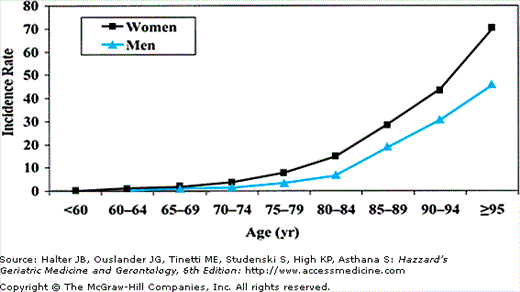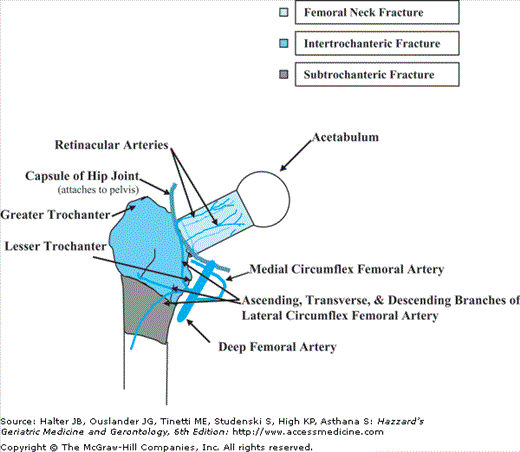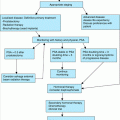Hip Fractures: Introduction
Hip fracture is a major public health problem with significant consequences for the older patients, their families, and the health-care system. In 2003, there were 310,000 hospital admissions for hip fracture in the United States alone. Recent worldwide estimates are in the order of 1.6 million hip fractures annually. By the middle of this century, the number is expected to more than double. As seen in Figure 118-1, hip fracture incidence increases exponentially in both men and women with advancing age. The average age of a patient with hip fracture is 82 years. Although hip fractures are thought to be a condition faced primarily by older white women, approximately 20% of hip fractures occur in men, and, in the United States, 8% occur in nonwhites. Prominent risk factors for hip fracture are osteoporosis and propensity to fall. Underlying these essential conditions for having a hip fracture are the reduced bone strength and quality that are characteristic of osteoporosis and the multiplicity of medical, psychosocial, and environmental factors that lead to falls.
The direct medical and indirect nonreimbursed costs (e.g., unpaid caregiving services and lost wages of patients and caregivers) of hip fracture have been estimated at more than $15 billion annually in the United States. Of those who have a hip fracture, approximately 18% of women and 36% of men are expected to die within the first year of their fracture, with the most dramatic increases in mortality seen within the first few months of a fracture among those who are in the poorest health. Comparison of survival in women with hip fracture to similarly impaired women without fractures indicates that the fracture itself is responsible for nine extra deaths per 100 patients during the first 4 years following the fracture. There also is suggestion from epidemiological data on women that even in those with the fewest medical comorbidities and best functioning at the time of fracture, the mortality attributable to hip fracture continues to increase well beyond the first year post fracture. Causes of death in women and men are similar and approximately four times greater than their nonfracture counterparts for heart disease, three times greater for cerebrovascular disease, and three times greater for chronic obstructive pulmonary disease. Interestingly, one recent study showed that men are far more likely than their nonfracture counterparts to die from infectious causes such as septicemia and pneumonia, in the first 2 years following hip fracture.
The intent of this chapter is to provide information about the medical and psychosocial status of the older patient who presents with a hip fracture and to discuss strategies for care and the role of the geriatrician in providing that care during the hospital stay and for the subsequent year or more of follow-up care.
What to Expect When Seeing Patients in Hospital
The cumulative effect of environmental exposures, lifestyle, and genetic influences results in a remarkably heterogeneous geriatric population. Aging impacts most organ systems, although the degree to which organs are impaired from aging varies from individual to individual. In addition, several chronic medical conditions may also exist in a given individual. Medical care of the patient with hip fracture must, therefore, be adapted to the individual patient’s needs. This requirement for a tailored approach to care is both the challenge and the pleasure of geriatric medicine.
The changes that occur with aging physiology result in decreased resilience to stress, or the so-called “homeostenosis” in most organs. For example, older individuals have stiffening of their rib cages and decreased mucociliary clearance of their lungs, resulting in an increased propensity toward postoperative atelectasis and pneumonia and poorer tolerance of these complications when these do occur. By mechanisms that are yet to be understood, older individuals can more easily become delirious during the pre- and postoperative period. This complication not only increases the patient’s risk of dying in the coming year, but also can impact an individual’s ability to participate in rehabilitation and significantly limit the patient’s ability to recover after a fracture. Because of this decreased physiological reserve, older individuals are at particular risk of a wider range of iatrogenic complications and do not recover as well when complications and adverse events do occur. Thus, all interventions must be monitored very closely to quickly determine their impact on the patient.
Classically, a patient with hip fracture presents with a painful, shortened, and externally rotated lower extremity after a fall and landing on the affected hip. Usually, but not always, patients are unable to bear weight on the extremity. There are many exceptions to this description, however. While a small percentage of hip fractures occur without trauma preceding the fracture event, nearly a third do not recall or cannot give a clear history of the precipitating fall. In nondisplaced femoral neck fractures, the extremity may be neither shortened nor externally rotated, and patients with stable impacted fractures or nondisplaced “hairline” fractures may be able to bear weight and ambulate. Occasionally, patients like this are sent home without fracture management but soon return for care, owing to continued pain and discomfort when ambulating. Thus, a better guiding principle is that all elderly patients with hip pain after trauma should be considered to have a hip fracture until proven otherwise. Similarly, patients having pain with gentle rolling of the lower extremity must be ruled out for hip fracture, irrespective of recollection of trauma.
Approximately half of all hip fractures occur in the area of the femoral neck (or “intracapsular fractures”), and the other half occur in the area between the greater and lesser trochanters (“intertrochanteric fractures” or “extracapsular fractures”). Far less common are fractures that occur within 5 cm below the lesser trochanter; these are called “subtrochanteric fractures.” Patients with intertrochanteric fractures tend to be older than those with femoral neck fractures and are more likely to have multiple medical comorbidities pre-fracture. A schematic of the hip anatomy is shown in Figure 118-2, which also indicates the anatomy of the vascular supply to the hip region. This schematic is useful to understand the various surgical approaches to hip fracture care and the potential for blood loss at each site. As demonstrated in the schematic, the regions of the femoral neck and the femoral head derive their main blood supply from fine retinacular arteries that stem from the medial circumflex femoral artery. These delicate vessels are closely apposed to the femoral neck in this region. Therefore, a fracture in this region of the hip, particularly if any displacement occurs, is more likely to disrupt the vascular supply to the femoral neck and head, which can result in longer-term nonunion and osteonecrosis. Thus, fractures in the femoral neck region, particularly displaced fractures, are usually replaced rather than internally fixed. In contrast, the blood supply to the intertrochanteric area is plentiful and redundant, such that nonunion and osteonecrosis are less common in this region, and often fractures in this area heal well if internally reduced with screws, nails, or pins.
Dementia is a prominent risk factor for falls and fractures, so, not surprisingly, a significant number of patients with hip fracture have underlying cognitive impairment. Delirium is also a very common occurrence both at time of presentation to the emergency department and especially postoperatively, where up to 60% may develop confusion after hip fracture repair, with underlying dementia again being a powerful risk factor for the development of delirium. The presence of delirium and cognitive impairment very significantly portends a worse functional recovery for patients with hip fracture. Identification of underlying dementia and especially identification of risk factors for delirium are important both prognostically and so that some of the modifiable risk factors may be eliminated in hopes of reducing the occurrence of delirium. Given the high risk of delirium in this patient population, it is particularly important to prepare the patient and family emotionally for this potential complication, especially in those with identified risk factors for delirium, as the manifestations of delirium can be quite frightening to unprepared family members.
Risk factors for delirium in hospitalized patients have been well described by many sources. Some of the most consistently reported risk factors include advanced age, sensory impairment, male sex, presence of comorbid psychiatric disease, the use of psychoactive drugs, infection, polypharmacy, use of restraints, sleep deprivation, and undertreatment of pain. Allowing people to sleep at night and remain active during the day, minimizing sensory impairment, promptly removing unneeded tethers such as Foley catheters and IVs, providing daily orientation, and careful attention to pain and medications may be useful in reducing the incidence of delirium in patients with hip fracture, as has been demonstrated in geriatric general medical in-patients. Undertreatment of pain, particularly in cognitively intact individuals with fracture, appears to be a more powerful predictor of the development of delirium than use of narcotics. In one study, proactive geriatric consultation with recommendations on oxygen delivery, fluid balance, analgesia, elimination of unnecessary medications, regulation of bowel and bladder function, nutritional intake, mobilization, prevention of postoperative complications, assessment of environmental stimuli, and treatment of agitated delirium reduced the incidence of delirium overall by a third and the incidence of severe delirium by half.
The Geriatrician’s Role in Caring for Patients with Hip Fracture on Entry into Acute Care and Recommendations Regarding Surgical Intervention
The geriatrician can serve a central role in caring for patients on entry into the acute hospital not only by evaluating the medical pre- and perioperative issues, and ensuring maximal medical stabilization prior to surgery, but also by providing vigilance and early detection of postoperative medical complications, by facilitating a smooth transition to rehabilitation or subacute care and by preparing the patient for long range preventive strategies to reduce future fractures.
Several studies demonstrate that services that use a multidisciplinary approach to acute care of the patients with hip fracture reduce medical complications and may shorten hospitalization, and the more involved the geriatrician is in providing or overseeing patient care, the greater the clinical benefits of the service. For example, a coattending model, in which both the geriatrics and the surgical services are responsible for the patient’s care, is more effective than daily consultation, and daily consultation is more effective than twice-a-week consultation in most studies.
The geriatrician can first help by providing a “big picture” view of whether or not the patient will benefit from pursuing surgery to repair the hip or not. Although for most patients with hip fracture, surgical approaches will typically offer more benefits than nonsurgical approaches, surgical repair is usually presented as the only option, despite the fact that nonsurgical approaches may be equally or more appropriate for some selected patients. The clearest benefit of surgery over the usual nonsurgical approach of bed rest, pain management, bowel regimen, and prophylaxis against pressure ulcers and deep venous thrombosis is that surgery results in better anatomic alignment and better likelihood of ambulation. There is currently no evidence that surgery provides better pain control over bed rest. Thus, in patients who are unable to ambulate prior to the fracture and who are not likely to ambulate later, or for those in whom surgical risks are very high or life expectancy is very short, nonsurgical approaches may be considered. Geriatricians, like other providers, need to be careful not to prematurely judge the patient’s likelihood of dying, since it may be difficult to base a prognosis on the presentation at the time of fracture and the determination of what might be most appropriate for a patient requires an understanding of that patient’s prior status, goals, and priorities as well as the patient’s medical conditions and psychosocial milieu to determine how the patient can best achieve those goals.
The majority of patients with a hip fracture will undergo surgical repair. The types of surgical approach and anesthesia employed are largely the purview of the surgeon and the anesthesiologist and often depend on local trends and the training of these physicians. Although, historically, regional anesthesia has been advocated over general anesthesia in frail elderly patients, observational studies suggest that there is little difference in short- and long-term outcomes with these two approaches.
In preparing a patient for hip fracture surgery, as with any surgery, one would determine the risks of cardiovascular, pulmonary, and other complications and strive to reduce those risks. (Refer to Chapter 35 for more details on the use of preoperative testing for risk stratification, preoperative pulmonary treatments, and the use of beta-blockers and other medications to reduce the risk of perioperative adverse cardiac events in high risk patients.) The geriatrician also is in a good position to step the patient and family through the many hospital and postacute care procedures and transitions that they can expect to encounter, thereby reducing uncertainty and alleviating anxiety at this unanticipated and challenging time.
Finally, while soliciting the preoperative history, the geriatrician is in a good position to use this opportunity to determine the patient’s risk for subsequent falls and fractures. A thorough falls history should be obtained, including a complete description of the fall that led to the fracture as well as any previous falls, with particular attention to remediable risk factors to be altered prior to discharge back to home (see Chapter 54). Similarly, the geriatrician may begin to prepare the patient, family, and other providers about the need to evaluate for and treat osteoporosis to reduce the risk of subsequent fractures after discharge back to home (see Chapter 117).
Postoperative Care in Hospital
Usually a patient will remain in the acute hospital for 2 to 5 days after surgery for hip fracture, although this may be longer in some health-care settings. Depending on the surgical approach used and the adequacy of the anatomic repair, most patients will resume a normal diet, have bladder catheters removed, and begin getting out of bed with physical therapy on postoperative day number 1. Early mobilization has been shown to be safe and is effective in minimizing deconditioning, reducing the risk of delirium, constipation, pneumonia, thromboembolism, and pressure ulcer formation. Adequate treatment of postoperative pain is useful in maximizing participation in physical therapy and increasing mobility.
The geriatrician must monitor the patient very closely for development of postoperative complications and is in a key position to detect subtle delirium that could be a harbinger of an ominous underlying complication, such as pulmonary embolus or pneumonia. Postoperative pulmonary complications are among the most lethal complications in this population, so the geriatrician should be particularly wary of these and enforce the use of deep breathing exercises with or without an incentive spirometer, early mobility, and use of physical and/or pharmacological approaches to reduce the risk of deep venous thrombosis. Other important postoperative medical considerations the geriatrician may be particularly adept at managing are reducing polypharmacy, maximizing sensory input, explaining the treatments and progression of care to patients and family, and communicating across the transitions to reduce errors during this vulnerable time.
Postfracture Changes in Physical and Psychosocial Function and Implications for Care
Hip fractures have significant effects on functioning and body composition. Figure 118-3
Stay updated, free articles. Join our Telegram channel

Full access? Get Clinical Tree










